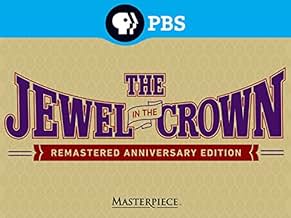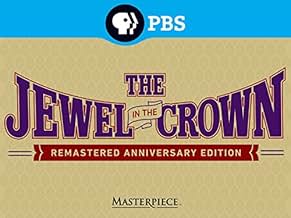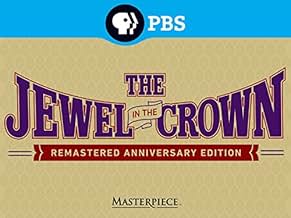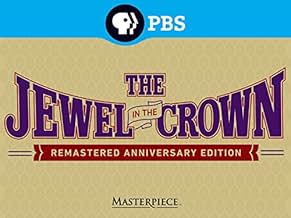Le Joyau de la couronne
Titre original : The Jewel in the Crown
- Mini-série télévisée
- 1984
- Tous publics
- 56min
NOTE IMDb
8,3/10
2,5 k
MA NOTE
Ce drame indien de la Seconde Guerre mondiale dépeint les conflits de classe et la lutte des populations pour s'adapter à des changements profonds.Ce drame indien de la Seconde Guerre mondiale dépeint les conflits de classe et la lutte des populations pour s'adapter à des changements profonds.Ce drame indien de la Seconde Guerre mondiale dépeint les conflits de classe et la lutte des populations pour s'adapter à des changements profonds.
- Récompensé par 1 Primetime Emmy
- 11 victoires et 18 nominations au total
Parcourir les épisodes
Avis à la une
There's a small scene in the first 2 hour episode of Jewel in the Crown about 80 minutes in. Susan Wooldridge, a gangly maladroit, clearly not cut out for India, is sleeping. The long awaited rain wakes her and she gets up and walks out onto the balcony. The obsessional loving care and artistry that is evident in just this single minute tell you everything you need to know about the quality of Jewel in the Crown. The set and the lighting on the sleeping figure momentarily transforms the character who will later be known, pejoratively as "that Manners girl" into the Diana-like beauty she always imagined she would become. Wooldridge is convincingly asleep and wakes naturally, and surprise, delight and relief register on her face as she revels in the feel of rain on her face. Nothing is out the book. It's all fresh, original, new. A great piece of acting by Wooldridge, never surpassed or even approached by all the other actors and actresses who have had to play this popular little scene, present in so many other movies. A great piece of directing, lighting, scene setting and costume design.
Aside from this one, there are 649 other minutes and the same care and devotion is taken with all of them. In the episode "The Mughal Room", Sara Layton and Guy Perron spend Guy's last afternoon exploring the Governor's Summer residence at Pankot. 7 minutes go by without any dialogue in this little elegy for the cobwebbed glory of the Raj before they settle down in one of the bedrooms to make love. You won't find anything else like it in mainstream television. Very hard to do but very beautiful.
But then the whole story is excellent, beautifully paced, tragic, funny, pathetic, illuminating and exciting by turns. I've watched it a number of times and I never want it to end.
It really is the best drama series ever made.
Aside from this one, there are 649 other minutes and the same care and devotion is taken with all of them. In the episode "The Mughal Room", Sara Layton and Guy Perron spend Guy's last afternoon exploring the Governor's Summer residence at Pankot. 7 minutes go by without any dialogue in this little elegy for the cobwebbed glory of the Raj before they settle down in one of the bedrooms to make love. You won't find anything else like it in mainstream television. Very hard to do but very beautiful.
But then the whole story is excellent, beautifully paced, tragic, funny, pathetic, illuminating and exciting by turns. I've watched it a number of times and I never want it to end.
It really is the best drama series ever made.
Apologies but those above who have slated the series by rubbishing the acting I feel, are seriously mistaken. Those who have said that the British characters were too reserved and meandering are quite correct - it is how British people were and definitely how they were portrayed in Paul Scotts original book. The beauty of the piece lies in its tender subtlety which provides in itself enough drama without constant high adrenaline action so common to the Hollywood Blockbuster. Tim Pigott Smith was just beautiful with his sadistic menacing Ronald Merrick who definitely goes top on my list of all time favourites. The whole piece when watched one after the other definitely gives the sense of time and place which - living in modern times it is often easy to lose sight of. Thumbs up to all the cast I feel that the acting from all members was superb.As the show progresses the viewer gets gradually enveloped and involved in the lives of these people the thing to remember about this piece is that it is not necessarily the action which enhances the show but more importantly the psychological development of every single character ( maybe with the exception on Aunt Fenny - funny but was only there for convenience - to introduce Sarah to Jimmy the soldier)
The haunting story of Paul Scott's THE RAJ QUARTET brought to the screen with flawless acting and character interpretation. While the story is not a pleasant one, the screenplay captures the scope of the problems created by nearly 300 years of British presence in India. Peggy Ashcroft, Fabia Drake, Judy Parfitt, Art Malik and above all Tim Pigott-Smith, to mention but a very few of the cast, create memorable characters that come alive on the screen and will live on in your memories. Superb...
It was brave of Yorkshire Television to take on a filmed adaptation of Paul Scott's massive novel 'The Jewel in the Crown'. All-in-all they did a good job of it. Wisely the script focuses in on the personal relationships within the context of a changing India. The jarring complexities of "old" India rubbing up against the modernizing influences of the British Raj is vividly conveyed, mostly in the smaller, quieter moments, as when Harry Kumar takes Daphne Manners to visit his aunt and the behavior of the servants and the Rajput princess with whom Daphne is living.
It's true that there is a great deal of dialog, in a soap opera-ish sense. There are times in some of the later episodes when I thought I was watching some bit of trash on TV on a Wednesday afternoon, but then I'd focus in on what the characters were saying and realize that it was deep and important stuff. You have to pay attention to 'The Jewel in the Crown' or it does indeed become a muddle and a bore. If you lose the train of thought you will not be rescued by brilliant cinematography or sound-track because both are inferior, which is a big shame. Perhaps it is the awful A&E dvds that are the problem, something that could be rectified with a remastering of the original films and sound- track. As it stands the sound is execrable, oftentimes the music and background rumble drowning out the speaking voices of the main characters. The musical score itself is wonderful and the actual camera-work is very good, which makes the loss of a good picture and decent sound-track all the more frustrating.
As for the acting, the thing is chocked-full of fine performances. Some of the characters are indeed a little too clichéd and, in the case of Ronald Merrick, completely over the top, but Merrick's character works, as a dramatic contrivance, to add to the melodrama of the story... something which may or may not have been the purpose of Scott's creation in the first place. But that's entertainment!
My favorite performances were Eric Portman's crafty old Russian emigré, Count Bronowsky. Porter was a great actor and is greatly missed. I savor his every appearance in 'The Jewel in the Crown' because he evokes the old Northern world of honor and good breeding, now extinct. His character makes me wish for a great film of the true story of the White Russians who had to flee the Bolsheviks in the first two decades of the 20th century, for such disparate places as India, Paris and Manchuria.
Susan Wooldridge is superb as Daphne Manners, ditto Art Malik as Harry Kumar. I enjoyed Charles Dance's upper-crust but manly Sergeant and found Derrick Branche's Ahmed Kasim a fascinating and seductive person. Peggy Ashcroft's old missionary lady is heart-breaking in the loss of her simple faith in God, conveying, in the end, a powerful and sibylline persona. It is good to see Rachel Kempson (Mrs Michael Redgrave) in one of her last roles on film. Tim Pigot-Smith manages to make an unbelievable character, Ronald Merrick, human, well, almost. He's a monster of bigotry, jealousy and class envy, and Pigot-Smith plays him so convincingly that it is difficult to imagine a more effective portrayal of pure evil by anyone else. Pigot-Smith steals the show, on the whole.
This TV series is definitely worth owning on DVD; if only A&E hadn't tossed it off in such a haphazard manner. Still, it's better 'n nuttin'.
It's true that there is a great deal of dialog, in a soap opera-ish sense. There are times in some of the later episodes when I thought I was watching some bit of trash on TV on a Wednesday afternoon, but then I'd focus in on what the characters were saying and realize that it was deep and important stuff. You have to pay attention to 'The Jewel in the Crown' or it does indeed become a muddle and a bore. If you lose the train of thought you will not be rescued by brilliant cinematography or sound-track because both are inferior, which is a big shame. Perhaps it is the awful A&E dvds that are the problem, something that could be rectified with a remastering of the original films and sound- track. As it stands the sound is execrable, oftentimes the music and background rumble drowning out the speaking voices of the main characters. The musical score itself is wonderful and the actual camera-work is very good, which makes the loss of a good picture and decent sound-track all the more frustrating.
As for the acting, the thing is chocked-full of fine performances. Some of the characters are indeed a little too clichéd and, in the case of Ronald Merrick, completely over the top, but Merrick's character works, as a dramatic contrivance, to add to the melodrama of the story... something which may or may not have been the purpose of Scott's creation in the first place. But that's entertainment!
My favorite performances were Eric Portman's crafty old Russian emigré, Count Bronowsky. Porter was a great actor and is greatly missed. I savor his every appearance in 'The Jewel in the Crown' because he evokes the old Northern world of honor and good breeding, now extinct. His character makes me wish for a great film of the true story of the White Russians who had to flee the Bolsheviks in the first two decades of the 20th century, for such disparate places as India, Paris and Manchuria.
Susan Wooldridge is superb as Daphne Manners, ditto Art Malik as Harry Kumar. I enjoyed Charles Dance's upper-crust but manly Sergeant and found Derrick Branche's Ahmed Kasim a fascinating and seductive person. Peggy Ashcroft's old missionary lady is heart-breaking in the loss of her simple faith in God, conveying, in the end, a powerful and sibylline persona. It is good to see Rachel Kempson (Mrs Michael Redgrave) in one of her last roles on film. Tim Pigot-Smith manages to make an unbelievable character, Ronald Merrick, human, well, almost. He's a monster of bigotry, jealousy and class envy, and Pigot-Smith plays him so convincingly that it is difficult to imagine a more effective portrayal of pure evil by anyone else. Pigot-Smith steals the show, on the whole.
This TV series is definitely worth owning on DVD; if only A&E hadn't tossed it off in such a haphazard manner. Still, it's better 'n nuttin'.
I really loved this series. I think I've seen the whole series about 7 or 8 times, and I see something new each time.
The Jewel in the Crown tells the story of individual people trying to live their lives in a world in the process of changing beyond recognition. The acting quality and execution of the entire production has never been equaled. You really believe that these people lived in this extraordinary time, the beginning of the end of the British Empire. Some are able to move forward into the new world, some are destroyed, and all are changed forever.
I actually think that the series is better than the sum of the books, but nothing beats the first book in the series (The Jewel in the Crown) as a stand-alone novel. It's all about human perspective. Similar to the film Rashomon (or Courage Under Fire), the novel Jewel in the Crown tells a story from every point of view except one. You have to think about what that means. The series captures this effect differently, but it does so beautifully.
The Jewel in the Crown tells the story of individual people trying to live their lives in a world in the process of changing beyond recognition. The acting quality and execution of the entire production has never been equaled. You really believe that these people lived in this extraordinary time, the beginning of the end of the British Empire. Some are able to move forward into the new world, some are destroyed, and all are changed forever.
I actually think that the series is better than the sum of the books, but nothing beats the first book in the series (The Jewel in the Crown) as a stand-alone novel. It's all about human perspective. Similar to the film Rashomon (or Courage Under Fire), the novel Jewel in the Crown tells a story from every point of view except one. You have to think about what that means. The series captures this effect differently, but it does so beautifully.
Le saviez-vous
- AnecdotesAll the exteriors of India were shot on location in India, but all the interiors of the Indian buildings were shot some six months later and 5000 miles away in the studios of Granada TV in Manchester, causing continuity problems because some of the cast had put on or lost weight in the meantime.
- Citations
Capt. Ronald Merrick: Are you one of those people who think that if you teach an Indian the rules of cricket he'll become an English gentleman?
Guy Perron: Hardly sir. I know quite a few English gentlemen who play cricket brilliantly but are absolute shits.
- ConnexionsEdited into Masterpiece Theatre: The Jewel in the Crown: Part 1 (1984)
Meilleurs choix
Connectez-vous pour évaluer et suivre la liste de favoris afin de recevoir des recommandations personnalisées
- How many seasons does The Jewel in the Crown have?Alimenté par Alexa
Détails
- Durée56 minutes
- Couleur
- Rapport de forme
- 1.33 : 1
Contribuer à cette page
Suggérer une modification ou ajouter du contenu manquant

Lacune principale
What is the Canadian French language plot outline for Le Joyau de la couronne (1984)?
Répondre










































